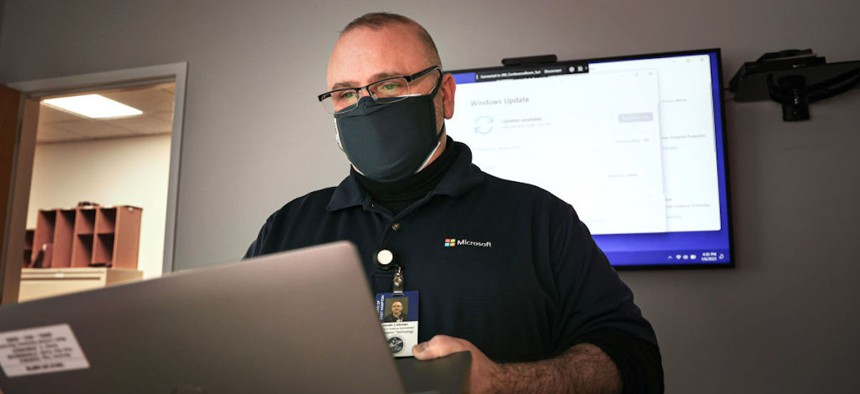How to make skills-based hiring work

Heath Liebman, network and systems administrator for the Town of East Hampton Department of Information Technology, is shown in his office in East Hampton, New York, on Friday, Jan. 6, 2023. John Paraskevas/Newsday RM via Getty Images
Now that many public sector jobs no longer require a four-year degree, agencies are reframing how they recruit and train new workers, especially for IT jobs.
It’s no secret that there are too many empty cubicles in state and local government offices, as agencies struggle to fill open positions, especially in tech fields. But few people consider work in the public sector, where lower salaries and legacy systems can’t match the allure of the private sector’s more innovative and lucrative environment. One way governments can increase their chances of attracting more job candidates, however, is by expanding the applicant pool.
To attract nontraditional candidates, state and local agencies must revamp their hiring and recruitment practices, according to a new report from Deloitte. With less than 15% of young adults wanting to work in the public sector, state and local governments “can’t afford to leave anybody behind,” said co-author Glenn Davidson, human capital transformation executive for Deloitte’s Government and Public Service practice.
A potential applicant scrolling through an online job board, for instance, may not even consider a position if the requirements include a college or grad school degree and several years of professional experience, he said.
To get more candidates interested, agencies should reframe job requirements to focus more on “the practical abilities of potential applicants to perform job-specific tasks … rather than educational or career history,” Davidson said.
While there is a risk to adopting this skills-based employment model, “there’s a risk in hiring the wrong candidate anytime,” Davidson said. But there are guidelines agencies can follow when hiring individuals on a skills-based standard.
One way managers can screen for the right candidate is through a trial period for new hires, during which managers can determine if the employee is a good fit, Davidson said. In California, for instance, individuals beginning a job in civil service are subject to a six- or 12-month probationary period so supervisors can evaluate the new hire’s performance and decide if they should continue working for the government.
Agencies can also conduct skills-assessment or project-based evaluations to gauge an applicant’s suitability for a government position, according to the report. An aptitude test, for instance, presents applicants with use-case scenarios so hiring managers can assess candidates’ ability to think critically and problem solve, Davidson said.
At least 16 states have passed legislation removing four-year degree requirements from certain public sector positions as of October, according to the National Conference of State Legislatures. In 2019, for instance, Indiana dropped degree requirements for most state IT roles. The same year, the state created a skills-based workforce development program that trains individuals for state government IT jobs.
A skills-based hiring model helps managers isolate the skills and attributes they care about most in IT workers, said Jon Rogers, director of strategic workforce planning at Indiana’s Office of Technology. While a college degree suggests an individual had formal education, “a B.S. in computer science is not the same from one institution to the next, whereas IT certifications are the same globally,” he said. Plus, data from 2020 shows that about 75% of potential candidates in Indiana did not apply to certain IT positions because of degree requirements in job postings.
Indiana’s State Earn and Learn program guides individuals’ transition from their previous job into an IT position, Rogers said. The work-based learning program targets people who are interested in IT but previously worked in different jobs, like as truck drivers, factory workers, mechanics or food service employees. Program associates cultivate their IT skills and obtain industry-standard certifications, such as CompTIA Network+ credentials.
Indiana’s goal is to hire associates to a full-time state employment seat once they complete the program. Since 2020, 57 individuals have been accepted into the program, and 40 participants continue to work with the state today, Rogers said.
In the program’s hybrid environment that includes classwork and on-the-job training, associates learn and practice the tasks and responsibilities of IT jobs and are mentored by previous participants. Mentors also support associates through the “culture” shift into an IT career by encouraging open communication. They provide one-on-one coaching, Rogers said, because many new program participants grapple with “imposter syndrome” as they learn to work in a new field.
During the 12-month program, participants train for certification in various IT specialties, including application development, cloud operations, disaster recovery, security operations and project management, among others. They also earn $18 an hour for the program’s 40-hour week schedule.
Ultimately, Rogers said, skills-based hiring can help agencies “find great people and give them a shot.”
Editor's Note: This story was changed Dec. 18 to correct attribution of education requirements to the National Conference of State Legislatures.






